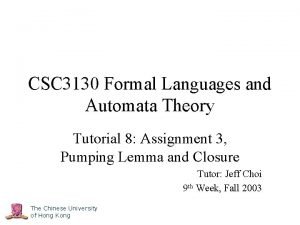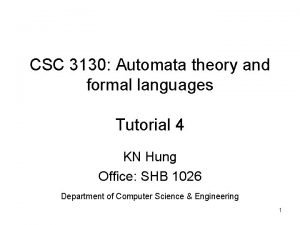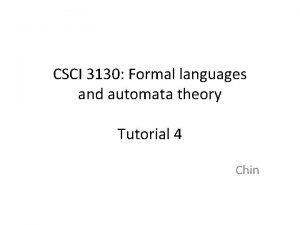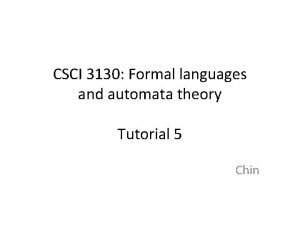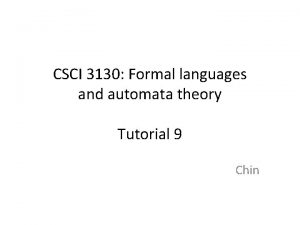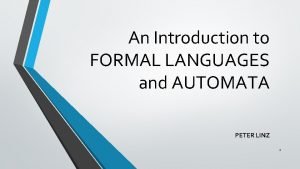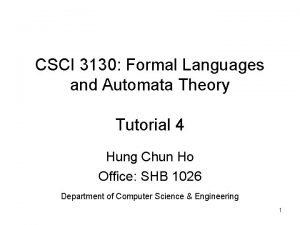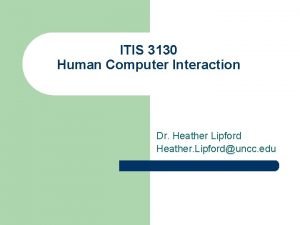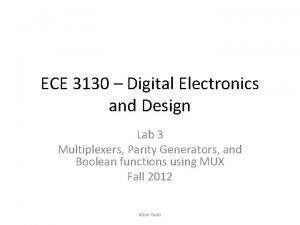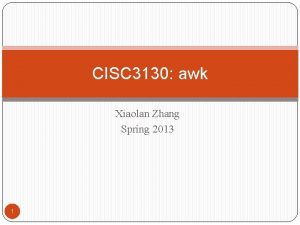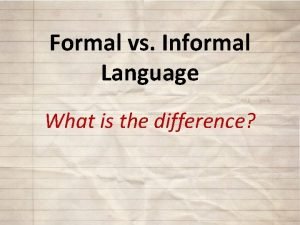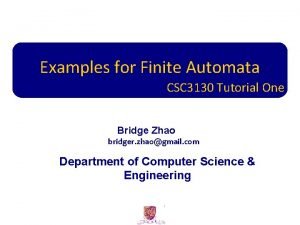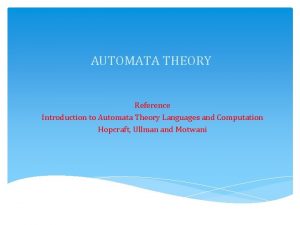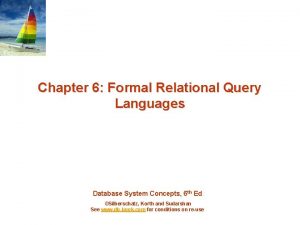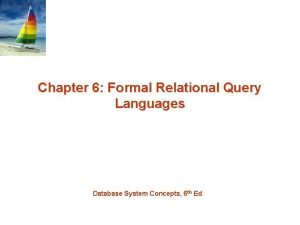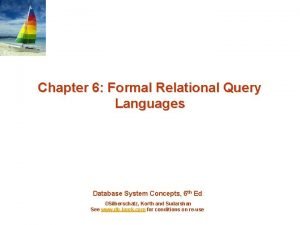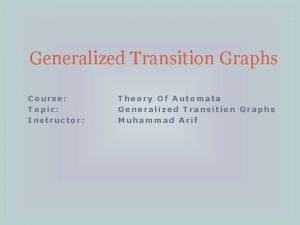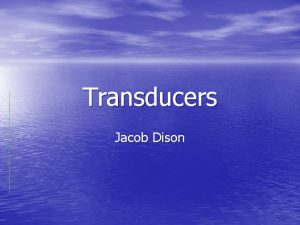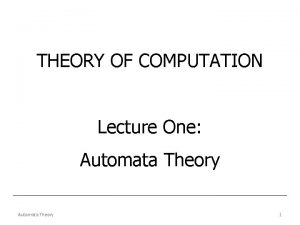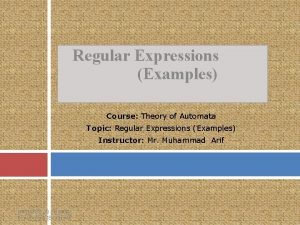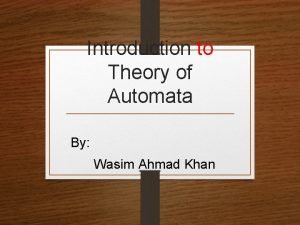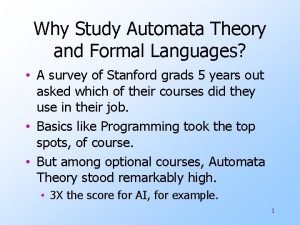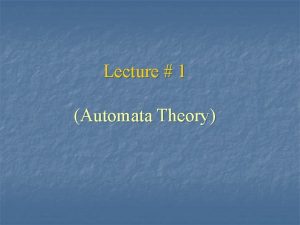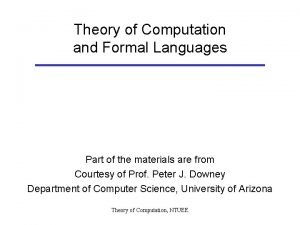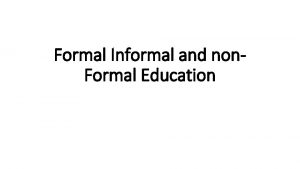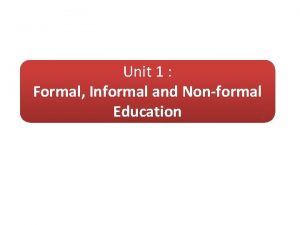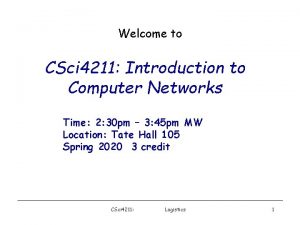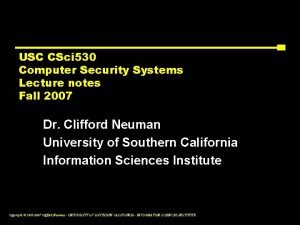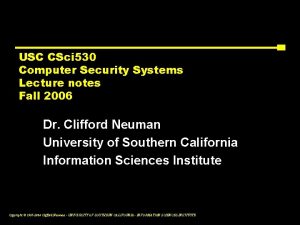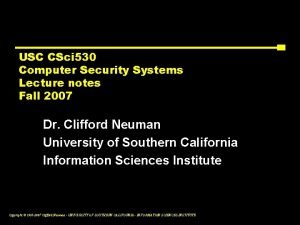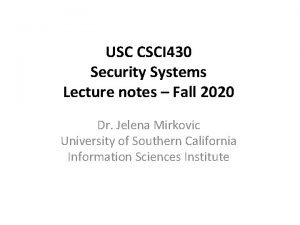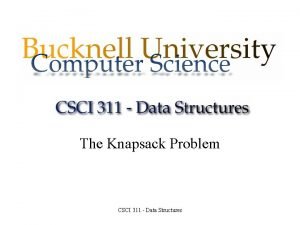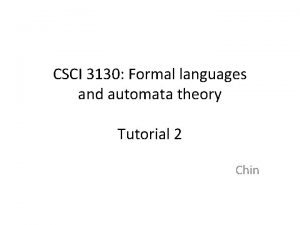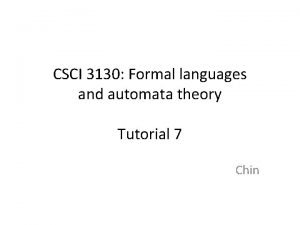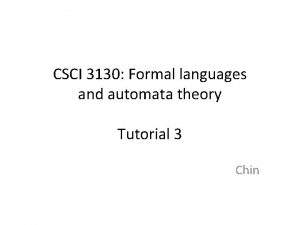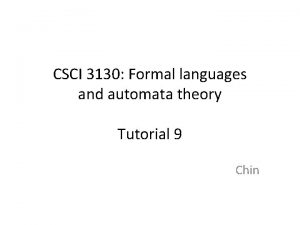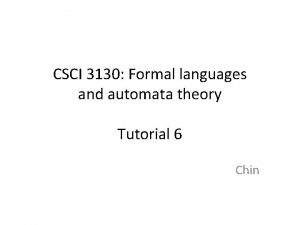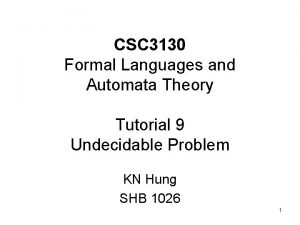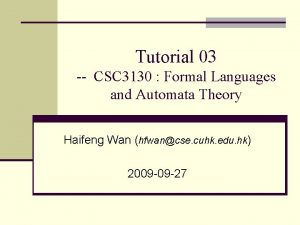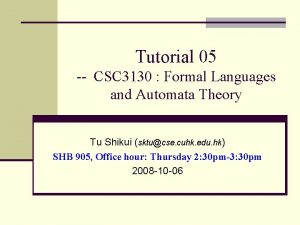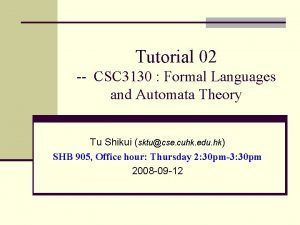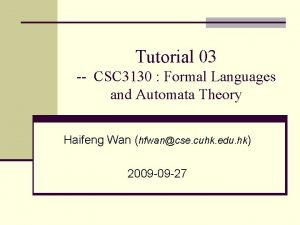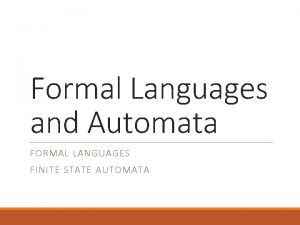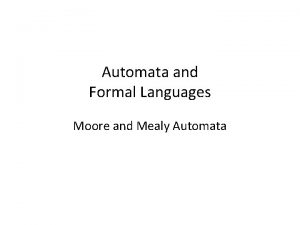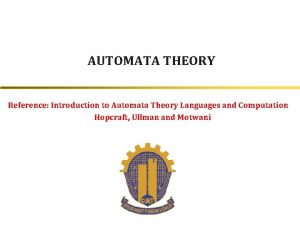CSCI 3130 Formal Languages and Automata Theory Tutorial










































- Slides: 42

CSCI 3130: Formal Languages and Automata Theory Tutorial 4 Hung Chun Ho Office: SHB 1026 Department of Computer Science & Engineering 1

Agenda • DFA Minimization – Algorithm – 2 Examples • Context Free Grammar (CFG) – Design – Parse Tree 2

DFA Minimization 3

DFA Minimization 0 q 000 0 1 q 001 1 … q 01 1 q 10 q 0 0 0 qe 1 q 1 1 q 2 q 111 1 1 q 11 1 1 … 0 q 3 q 101 … q 00 1 … 1 0 q 1 1 0 0 0 q 0 We will show to turn any DFA for L into the minimal DFA for L 4

DFA Minimization • After we design a DFA, there may be some redundant states – They have the same “function” – They are indistinguishable – No matter what happens in the future (inputs), they will have the same fate (accept/reject)! • We can merge indistinguishable states into groups 5

Indistinguishable States • DFA example from lecture note • Indistinguishable states example: {q 0, q 00} • Explain: next few slides 0 0 0 q 00 1 1 qe q 01 1 1 0 q 1 1 q 10 0 1 q 11 1 6

Indistinguishable States • On continuation string (further input) “ 0” • q 0 Reject • q 00 Reject 0 0 0 q 00 1 1 qe q 01 1 1 0 q 1 1 q 10 0 1 q 11 1 7

Indistinguishable States • On continuation string “ 11” • q 0 Accept • q 00 Accept 0 0 q 00 1 1 qe q 01 1 1 0 q 10 0 1 q 11 1 8

Indistinguishable States • On continuation string “ 01011” • q 0 Accept • q 00 Accept 0 0 0 q 00 1 1 qe q 01 1 1 0 q 1 1 q 10 0 1 q 11 1 9

Indistinguishable States • On all continuation strings, {q 0 , q 00} have the same outcome • q 0 , q 00 are indistinguishable 0 Can be merged 0 0 q 00 1 1 qe q 01 1 1 0 q 1 1 q 10 0 1 q 11 1 10

How to find? • Infinitely many continuation states – A bit difficult to find indistinguishable states directly • We do the reverse: – To recognize distinguishable states – Pair of states, s. t. there is a continuation string, causing them have different “fates” – (De Morgan’s Law, still remember? ) 11

Distinguishable States • • For continuation string = “ 1” q 01 Accept q 10 Reject 0 Distinguishable 0 0 q 00 1 1 qe q 01 1 1 0 q 1 1 q 10 0 1 q 11 1 12

Distinguishable States • • For continuation string = “e” q 10 Reject q 11 Accept 0 Distinguishable 0 0 q 00 1 1 qe q 01 1 1 0 q 1 1 q 10 0 1 q 11 1 13

Distinguishable States • 2 states are distinguishable, if there is a continuation string, that bring them different fate!! (Accept / Reject) – Try all continuation strings? How? • Idea: – For any pair of {Accept, Reject} states, they are distinguishable – For these pairs, walk k transitions backward, mark the obtained pairs as distinguishable 14

Finding (in)distinguishable states Rule 1: Rule 2: q x q’ q 1 x q 1’ a q 2 a x q 2’ If q is accepting and q’ is rejecting Mark (q, q’) as distinguishable (x) If (q 1, q 1’) are marked, Mark (q 2, q 2’) as distinguishable (x) Unmarked pairs are Repeat !! indistinguishable as long as you mark Merge them into groups Rule 3: some pairs 15

Example 1 0 0 0 q 00 q 01 1 1 0 q 1 1 1 qe q 0 q 10 0 q 11 1 q 00 q 01 q 10 q 11 1 x x x qe q 0 q 1 q 00 q 01 q 10 q 11 is distinguishable from all other states 16

Example 1 0 0 0 q 00 q 01 1 1 0 q 1 1 1 qe q 0 q 10 0 q 11 1 q 00 q 01 q 10 q 11 1 0 1 x x x qe q 0 q 1 q 00 q 01 q 10 Look at pair qe, q 0 Neither (q 0, q 00) nor (q 1, q 01) are distinguishable 17

Example 1 0 0 0 q 00 q 01 1 1 0 q 1 1 1 qe q 0 q 10 0 1 q 11 q 00 q 01 0 1 q 10 q 11 1 x x x x qe q 0 q 1 q 00 q 01 q 10 Look at pair qe, q 1 (q 1, q 11) is distinguishable 18

Example 1 0 0 0 q 00 q 01 1 1 0 q 1 1 1 qe q 0 q 10 0 q 11 1 x q 00 q 01 x x q 10 x x x x q 11 1 x x x qe q 0 q 1 q 00 q 01 q 10 After going thru the whole table once Now we make another pass 19

Example 1 0 0 0 q 00 q 01 1 1 0 q 1 1 1 qe q 0 q 10 0 q 11 1 x q 00 q 01 x x q 10 x x x x q 11 1 x x x qe q 0 q 1 q 00 q 01 q 10 In the second pass, nothing changes So we are ready to apply Rule 3 20

Example 1 q 0 qe q 1 q 00 q 01 q 10 q 11 q 0 q 1 x x x q 00 q 01 x x q 10 x x x x q 11 x qe q 0 q 1 q 00 q 01 q 10 Merge unmarked pairs into groups Unmarked Cells Pairs of Indistinguishable states Blue links indistinguishable states 21

Example 1 q 00 q 0 A q 01 qe B q 10 q 11 C q 0 q 1 q 00 q 01 q 10 q 11 A x A x x B x x A x x x qe q 0 q 1 q 00 q 01 q 10 Merge unmarked pairs into groups 22

Example 1 0 0 A 0 q 00 q 01 1 1 B 0 q 1 1 1 qe q 0 q 10 0 q 01 1 0 1 q 00 0 q 11 C q 11 A x A x x B x x A x x x qe q 0 q 1 q 00 q 01 q 10 1 0 minimized DFA: q. A 1 0 q. B 1 q. C 1 0 23

Example 2 0 0 0 q 00 q 01 1 1 0 q 1 1 1 qe q 0 q 10 0 q 11 1 q 00 q 01 q 10 x x x q 11 1 qe q 0 q 1 q 00 q 01 q 10 is distinguishable from all other states 24

Example 2 0 0 0 q 00 q 01 1 1 0 q 1 1 1 qe q 0 q 10 0 q 11 1 q 00 q 01 q 10 q 11 1 x x x x qe q 0 q 1 q 00 q 01 q 10 After going thru the whole table several times (See white board for simulation) 25

Example 2 0 0 0 q 00 q 01 1 1 0 q 1 1 1 qe q 0 q 10 0 1 q 11 q 00 q 01 q 10 q 11 1 x x x x qe q 0 q 1 q 00 q 01 q 10 Merge unmarked pairs into groups 26

Why it works? • For a pair of states, there is a continuation string that bring them different fates – Distinguishable • Idea: For any pair of {Accept, Reject} states, they are distinguishable, mark them – These pairs have a length-0 continuation string that distinguishes them • 1 step backward, mark them as distinguishable – These pairs have a length-1 continuation string that distinguishes them 27

Why it works? • 1 further step backward, mark – These pairs have a length-2 continuation string that distinguishes them • 1 further step backward, mark – These pairs have a length-3 continuation string that distinguishes them • So-on … 28

Context Free Grammar 29

Context-Free Grammar (Recap) • A context free grammar is consisted of Another Terminal 4) Start Variable S AB | ba 3) Production Rule A a. A | a B b 1) Variables Another Production Rule 2) Terminal 30

Context-Free Grammar (Recap) • A string is said to belong to the language (of the CFG) if it can be derived from the start variable = Apply Production Rule CFG Example Derivation S AB | ba S AB A a. A | a a. AB B b aa. B Therefore, aab belongs to the language aab 31

Why CFG? • L = {w = 0 n 1 n : n is an positive integer} • L is not a regular language – Proved by “Pumping Lemma” • A Context-Free Grammar can describe it S 0 S 1 S 01 • Thus, CFG is more general than regular expression – Recall: NFA Regular Expression DFA 32

CFG Design • Given a context-free language, design the CFG • L = { ab-string, w : Number of a’s < Number of b’s } • Some time for you to get into think… 1 min S ? … 33

CFG Design (Con’t) • Idea: Bottom-up – Shortest string in L : “b” – Given a string in L, we can expand it, s. t. it is still in L – i. e. , Add terminals, while not violating the constraints 34

CFG Design (Con’t) Good Try: S b S b. S | Sb S ab. S | ba. S | b. Sa | a. Sb However, cannot parse strings like “aabbbaa” Explaination makes sense. But there is a counter example. After adding 1 “b”, number of “b” is still greater than that of “a” Adding 1 “a” and 1 “b”, the difference between the numbers of “a” and “b” keep constant 35

CFG Design (Con’t) Consider the answer: S b S SS S Sa. S | a. SS | SSa Base Case #b still > #a 1 st S : #b ≥ #a + 1 2 nd S : #b ≥ #a + 1 ‘a’ : #a = 1 SUM #b ≥ #a + 2 - 1 Explaination makes sense. But, is the grammar is correct? 36

CFG Design (Con’t) • After designing the grammar, G, you may have to prove (if required) that the language of this grammar is equivalent to the given language • i. e. , Prove that L(G) = L • Proof: A set of strings Part 1) L(G) ⊂ L Part 2) L ⊂ L(G) • Due to time limit, I will not do this part 37

Parse Tree • How to parse “aab” in this grammar? (Previous example) CFG Example Derivation S AB | ba S AB A a. A | a a. AB B b aa. B aab 38

Parse Tree (Con’t) • Idea: Production Rule = Node + Children • Should be very intuitive to understand S Derivation S AB A B a. AB aab a A b a 39

Parse Tree (Con’t) • Ambiguity: String: 3 - 1 - 2 CFG: S S-S S 1|2|3 S S 3 - - S S 2 3 A - S S - 1 1 3– 1– 2 3 – (1 – 2) Different parse trees! The grammar is ambiguous! S 2 40

Parse Tree (Con’t) • Useful in programming language – CSC 3180 • Useful in compiler – CSC 3120 41

End • Thanks for coming! • Any questions? 42
 Csci 3130
Csci 3130 Formal languages and automata theory tutorial
Formal languages and automata theory tutorial Cyk algo
Cyk algo Automata theory tutorial
Automata theory tutorial Automata theory tutorial
Automata theory tutorial Csci 3130
Csci 3130 Automata theory
Automata theory Allcfg
Allcfg An introduction to formal languages and automata
An introduction to formal languages and automata Automata theory tutorial
Automata theory tutorial Heather lipford
Heather lipford Ece 3130
Ece 3130 Ece 3130
Ece 3130 Ece 3130
Ece 3130 Cisc 3130
Cisc 3130 Formal vs informal vocabulary
Formal vs informal vocabulary Characteristics of informal writing
Characteristics of informal writing Csc3130
Csc3130 The central concepts of automata theory
The central concepts of automata theory Formal relational query languages
Formal relational query languages Formal relational query languages
Formal relational query languages Formal relational query languages
Formal relational query languages Generalized transition graph
Generalized transition graph Bidirectional transducers in automata theory
Bidirectional transducers in automata theory Automata theory
Automata theory Automata theory
Automata theory Is regular expression a language
Is regular expression a language Valid and invalid alphabets
Valid and invalid alphabets Aaaaaabb
Aaaaaabb Why we study automata theory
Why we study automata theory Reverse of a string in automata theory
Reverse of a string in automata theory Types of languages in theory of computation
Types of languages in theory of computation Non formal education examples
Non formal education examples Whats formal education
Whats formal education Difference between formal education and als
Difference between formal education and als Csci 4211
Csci 4211 Csci 530
Csci 530 Csci 530 security systems
Csci 530 security systems Csci 530 security systems
Csci 530 security systems Csci430
Csci430 Contoh knapsack problem
Contoh knapsack problem Csci 420
Csci 420 Scott warfield ucf
Scott warfield ucf

